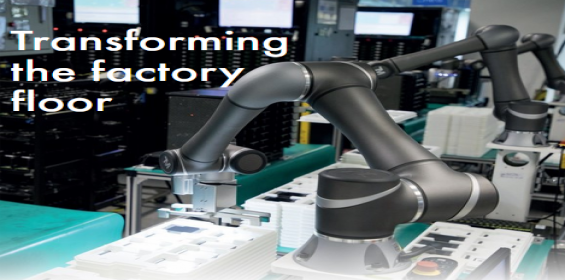Transforming the factory floor
Published: 30 September, 2021
We’ve seen a gradual increased presence of robots on manufacturing factory floors, and industries that have embraced automation have seen an increase in efficiency and productivity. Gary Livingstone* reports
There is a key concern amongst employees that the rise of robots will ensure the human worker extinct. This concern is mostly unfounded and is a result of scaremongering. In more recent years, new ways of thinking have gained traction; rather than make their human counterparts redundant, the manufacturing robots of the future will work collaboratively alongside them. This future can be witnessed with the introduction of collaborative robots, commonly known as “cobots”, robots invented to complement human workers, operating in almost any environment. While we excel at complex thinking and problem-solving, robots are proficient at bringing accuracy to repetitive, and sometime unsafe, time-sensitive tasks.
What if robots do all the heavy-lifting and monotonous error-prone tasks, and employees are able to focus on more challenging and meaningful work. What if production lines were able to flow unsupervised with minimal error? The workforce of the future sees robots working collaboratively with employees and complement their work, improve efficiency, and increase productivity. Well, that future already exists.
Small, lightweight, and designed to operate safely for close human operation, cobots are an ideal entry point for many businesses looking to embrace robotics. Cobots can execute tasks with minimal programming and can be adapted to integrate into existing processes. Cobots are a world away from their industrial robot counterparts and well suited to SMEs. Around the world these collaborative robots are widely integrated and viewed simply as tools that coexist alongside human employees – allowing them to be more efficient.
Cobots are increasingly attractive to manufacturers who require flexible solutions for their production lines but may not have the capital needed to justify large investments in automation systems.
A recent study by Massachusetts Institute of Technology (MIT) found that cooperation reduced human idle time by 85%, making cobot human working more productive than purely human or robot teams. In the UK, cobots are completing all manner of tasks from stacking crates, painting, and welding to sticking on car door liners and basic QA inspections. The cobots’ lower cost and easy programming enables more businesses to implement them into their production processes. With their refined torque-sensing capabilities and lightweight but still solid construction, they are safer to use and easy to deploy. The ability to adapt their software to suit means they can quickly be redeployed to add flexibility to your operations.
Going forward, what will this look like?
According to a report by the International Federation of Robotics (IFR), international sales for robots reached almost £10 billion last year, and has been increasing since 2017. The IFR predicts “a strong sales increase” in the coming years, particularly of robotic systems used for logistics, which is expected to more than double by 2022. Future automation across all areas of manufacturing is inevitable, however with increasing development of cobots, there is no danger in them taking over completely as they need human intervention for connectivity and programming, for example, to carry out their purpose. Obviously, in the future there’s no doubt that many tasks that we do today will be taken over by cobots, but for an industry that suffers from skills shortages like manufacturing and the ongoing rise in UK wages, this may be a positive move. Using cobots provides many companies with an opportunity to upskill their employees, alleviating the dependency these skill shortages have caused.
This collaborative future has the potential for new, historically unimaginable, benefits. Rather than merely streamlining how businesses currently manufacture, it allows cobots to serve as a workhorse across organisations, transforming how businesses work and how they go about it.
*Gary Livingstone is managing director at LG Motion
https://www.linkedin.com/company/lg-motion/







